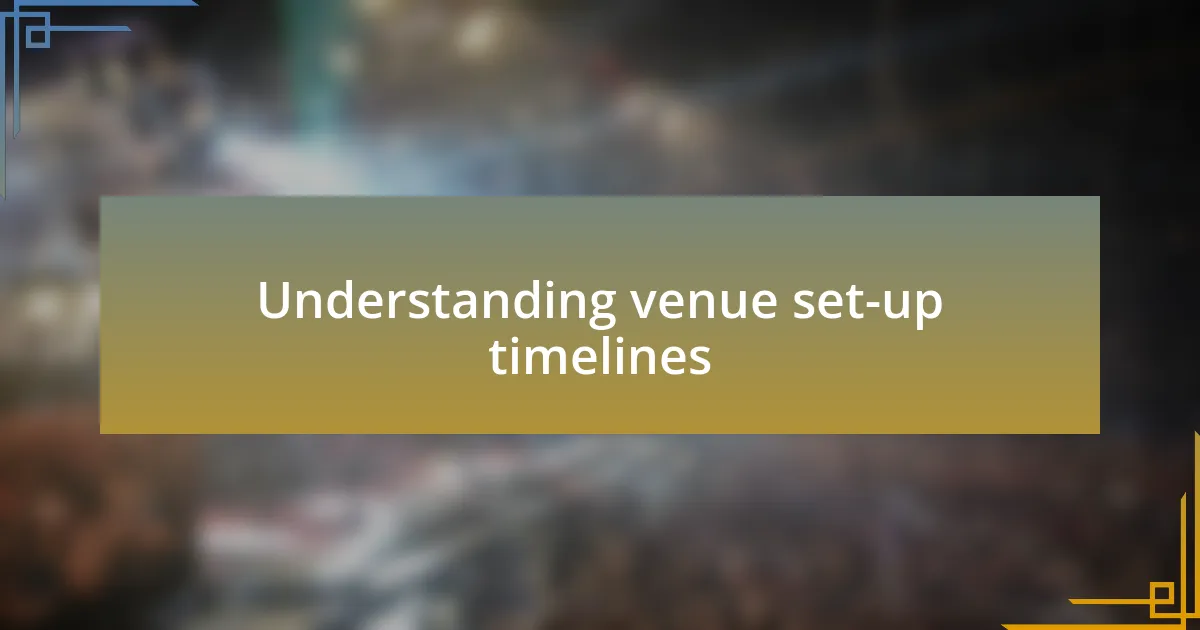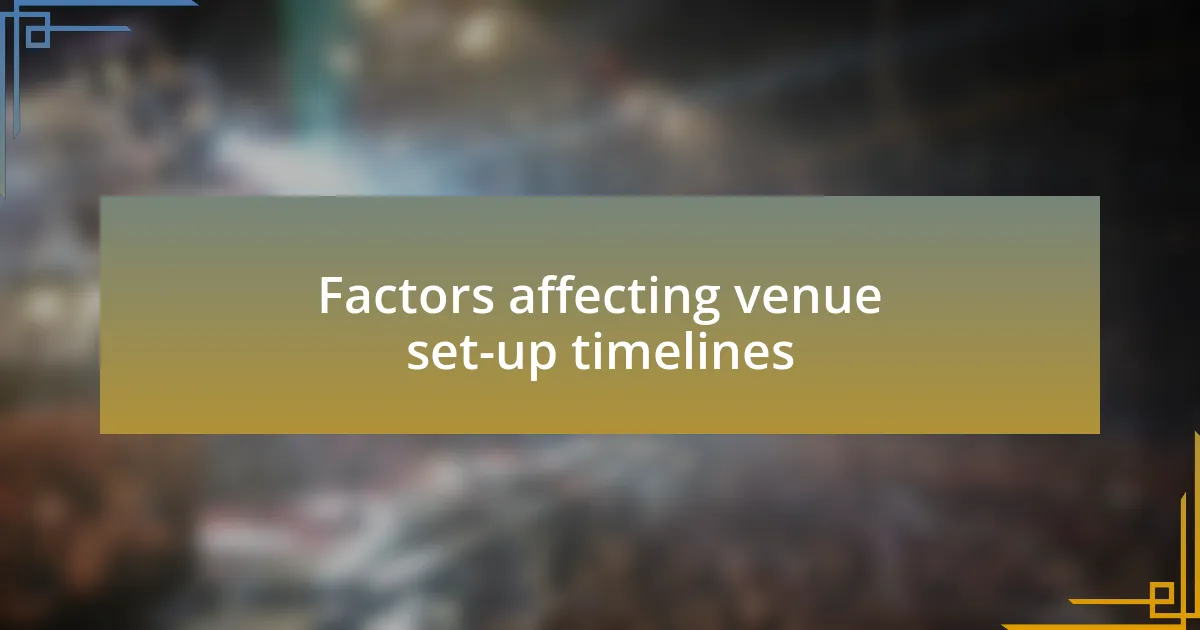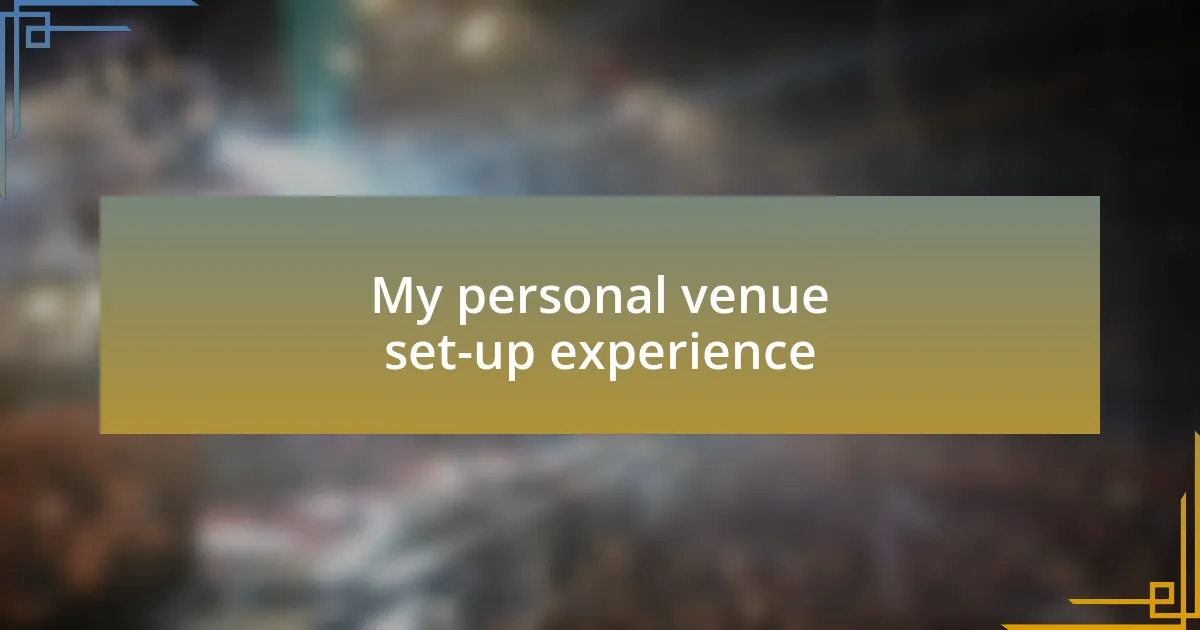Key takeaways:
- Understanding venue set-up timelines is crucial for a smooth event; synchronization of vendor schedules significantly reduces stress and chaos.
- Key factors like venue layout, weather conditions, and vendor experience can greatly impact the set-up process and timelines.
- Effective communication and proactive adjustments are essential for handling unexpected changes during the event planning process.
- Creating a visual timeline and designating specific tasks to team members enhances efficiency and clarity in managing venue set-up.

Understanding venue set-up timelines
When I worked on a wedding at a beautiful barn venue, I learned firsthand that understanding venue set-up timelines can make or break the event. It’s essential to know how much time each aspect of the setup requires and allow for unexpected delays. Have you ever been in a rush to get things done and felt that familiar twinge of rising stress? I certainly have, and it often stems from underestimating timeframes.
One key takeaway is remembering that each vendor has its own schedule. For instance, my florist needed extra time to arrange stunning centerpieces, while the caterer had strict setup protocols. I recall a moment when everything felt chaotic, but once we synchronized the timelines, everything fell into place like a well-oiled machine. Could my wedding have gone off without a hitch without that planning? Probably not.
Lastly, what I’ve found is that communication is everything. Regular check-ins with your venue can help clarify the set-up process and even catch any issues before they escalate. One particular wedding I coordinated had a last-minute change that could have derailed the entire timeline. Yet, with a clear understanding and proactive adjustments, the day turned out beautifully. So, how prepared will you be when that unexpected situation arises?

Factors affecting venue set-up timelines
When I think about the space itself, I realize that the venue’s layout can significantly impact set-up timelines. For example, at one wedding I coordinated, the expansive outdoor area required additional time for seating adjustments due to an unexpected increase in guest count. I remember feeling the pressure as I tried to keep everything on track. Have you ever felt the weight of a ticking clock? Managing that kind of stress is tough, especially when every minute counts.
Weather conditions also play a crucial role in the preparation process. I once faced an unforeseen rainstorm hours before a garden wedding, forcing us to shift tables and décor indoors. This last-minute change not only strained our timeline but also heightened the emotions of everyone involved. It taught me how adaptable you need to be in these situations. How would you handle such a surprise?
Then there’s the matter of the team involved. Each vendor’s experience and efficiency can either expedite or delay the set-up process. I recall working with a new bartender who took much longer than expected to organize the bar area, leaving us scrambling as guests began to arrive. It was a valuable reminder that a well-coordinated, experienced team can make all the difference on the big day. Have you considered how important each individual is in the larger picture?

My personal venue set-up experience
I remember my first big wedding venue set-up like it was yesterday. The atmosphere in the room was electric, but the clock was ticking loudly in the background. I felt a mix of excitement and anxiety as I navigated through the tasks. I had underestimated how much coordination was needed; I found myself with a checklist in hand, mentally calculating how long each setup would take. Have you ever been in a situation where the excitement is so palpable but the clock makes it feel like a race against time?
One key lesson I learned happened during a charming rustic venue set-up. As I arranged the tables and added centerpieces, I noticed that the lighting was off. It wasn’t just about aesthetics; the mood impacted everything from guest enjoyment to photographs. In that moment, I had to make a quick decision—adjust the lights now or wait until later? I chose to act immediately, prioritizing the ambiance, and it ended up being one of the best decisions of the day. How do you determine what needs your immediate attention when the pressure mounts?
Lastly, I’ll never forget the time I had to adjust the layout last minute because a couple surprised us with a guest list that was much larger than anticipated. I could feel my heart race as chairs were rearranged and the dance floor was shifted to accommodate everyone. The support from the team was incredible, and I felt an overwhelming sense of camaraderie as we worked together in the face of chaos. Isn’t it remarkable how a setback can turn into an opportunity for unity?

Tips for efficient venue set-up
One of the most valuable tips I’ve picked up for efficient venue set-up is to prioritize tasks by creating a visual timeline. I find that having a clear sequence of events not only helps keep everyone on track but minimizes the overwhelming feeling as the big day approaches. Have you ever felt lost in a sea of tasks? Breaking it down into manageable chunks was a game changer for me.
During a particularly hectic wedding I worked on, we implemented a system of designated zones for specific tasks. While one team focused on decor, another tackled the seating arrangement. It reminded me of how a well-coordinated team can make all the difference. When everyone knows their role, everything runs smoother. Wouldn’t you agree that clarity can transform chaos into harmony?
I’ve also learned the importance of early testing, especially with tech setup. At one event, we discovered that the sound system had a glitch only moments before the ceremony started. Thankfully, we had allocated time earlier in the day for audio checks, which allowed us the necessary adjustment time. It was nerve-wracking, but being proactive saved the moment. How often do we overlook the basics, thinking they’ll be fine? Sometimes those little details can make or break the experience.